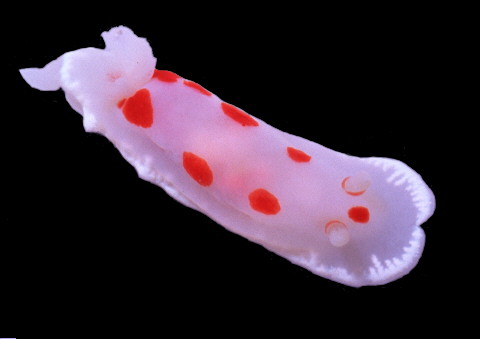
| Chromodoris heatherae Cape Town, South Africa Ron McPeak 1996 |
Chromodoris heatherae, Gosliner, 1994
One of five chromodoridid opisthobranchs described in the 1994 paper from the western Indian Ocean and southern Africa, this species was named to recognize Terry Goslinerís daughter Heather, who was born in Cape Town, South Africa, where this species is common. Like the human, Heather, it is a very pretty sea goddess, only much smaller reaching about 70 mm in length.
A temperate species, it is found along Cape Province from the Atlantic
coast of the Cape Peninsula to Port Elizabeth. It is common from the intertidal to depths of 23 meters. The body is white with white gills
and rhinophores. A band of numerous, crowded, opaque white glands is present along the margin of the notum. At this point the coloration of specimens can vary widely. At one extreme, some specimens have no spots, and a few had an additional submarginal yellow band along the edge of the notum. A series of blood-red spots are arranged over the surface of the notum, in most
specimens. In some these spots are uniform in size and shape, arranged in a neat double row, while in others the spots are quite irregular in shape, dispersed more densely to the posterior end. Shown originally (Figure 112) in Goslinerís Nudibranchs of South Africa, A guide to the opisthobranch molluscs of Southern Africa published in 1987 by Sea Challengers!. C. heatherae is similar in color pattern to several species found in temperate Australia
(Rudman, 1983). Among these are C. splendida (Angas, 1864) and C. hunteri Rudman, 1985. Gill and notal coloration and the dentition of
the radular teeth set C. heatherae apart as a distinct species.
The photo taken here by " Ron Ron, the Biomass Mawn" is very typical of
this lovely species, one any proud father would want to name after his
lovely daughter.
Ron McPeak and son Ken at La Jolla Shores

|
I'm one of the lucky ones, having turned an avocation into a profession. I obtained a degree in Zoology from Long Beach State University in 1964, and a Masters in Biology from the University of Southern California in 1967. I spent nearly 25 years working as a diving marine biologist for Kelco Company, in San Diego, California where I managed the Marine Resource Department and researched kelp forests of California and Mexico. In 1993, I started my own company, Global Biological Consultants. My wife and I moved to Battle Ground, Washington in 1996. I'm presently doing consulting work for Kelco on world kelp resources, collecting biomedical samples for Merck & Co., Inc., and working as a naturalist and divemaster for Society Expeditions in the South Pacific. I've logged more than 5400 dives since becoming certified in 1956. The joy of diving, exploration, and underwater photography is still as strong as ever.
I spent nearly three weeks in South Africa diving and collecting marine samples for Merck & Co., Inc. late February through mid March, 1996. The diving was fantastic and the diversity of biota was tremendous. Slightly more than two weeks were spent near Cape Town, Scuba diving, snorkeling and shore collecting. One could usually find good to excellent diving on the False Bay side (east) of the Cape Peninsula or the Atlantic side (west). The coast around Cape Peninsula reminded me of California, however, the species were different. Upwelling was common on the Atlantic side, forests of canopy-producing bull kelp (Ecklonia maxima) fringed the coast, abalone (perlemoen) and lobsters were abundant, biota was diverse. Large granite boulders in shallow water created a labyrinth of caves rich in sponges, tunicates, molluscs,and especially nudibranchs. The gas flame nudibranch, Bonisa nakaza, was one of the more spectacular branchs seen in the Cape Town area. I drove along the Garden Route, approximately 450 miles, to the east of Cape Town to Port Elizabeth. Sea surface temperatures warm considerably as one moves to the east. Ocean temps near Cape Town ranged from the high to low 50s (A 100 ft. dive was 49 degrees F.). I made several dives at Phillip's Reef, off Port Elizabeth. Temps were in the mid to low 60s and the bottom was entirely different from Cape Town. Phillip's Reef was cobble or low relief with much sand. The bottom was basically a garden of sea fans, sponges, and brightly-colored compound tunicates. Rich tidepool areas exist near Port Elizabeth to the west.
I spent two days diving at Port Elizabeth with Brian Hayes, a shell dealer, and two days collecting intertidally before heading northeast to the Tumbavati Game Reserve. It was here that I switched to beetle collecting and dung beetle watching. There is nothing quite like watching a couple dozen large dung beetles tear into a pile of elephant dung. I'll leave you with that lasting image.
|
Taxonomic information courtesy of:

David W. Behrens
Author:
Pacific Coast Nudibranchs
Send Dave mail at seachalleng@earthlink.net
|
© The Slug Site, Michael D. Miller 1998 All Rights Reserved.
